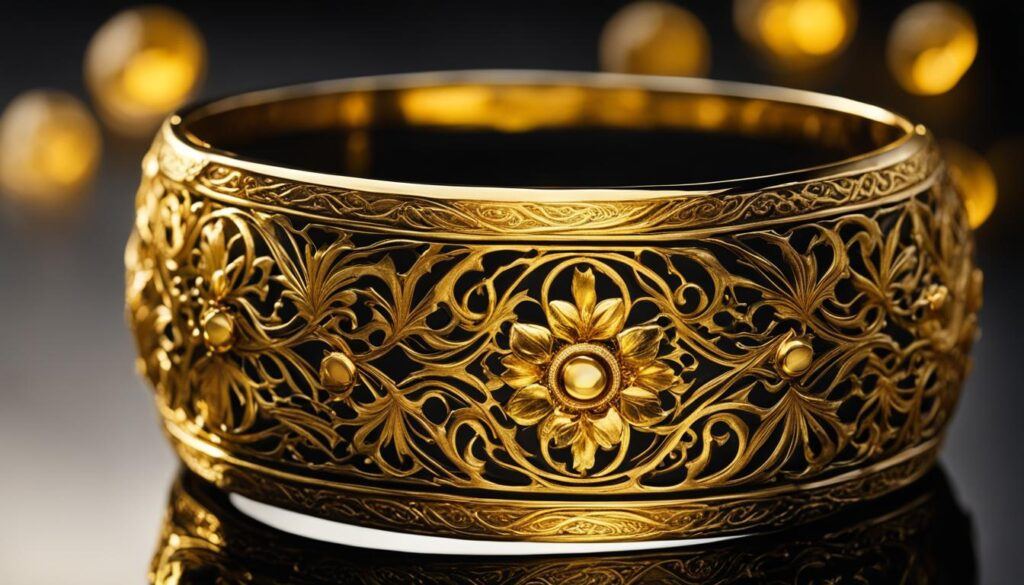Indian gold is known for its distinct yellow hue that sets it apart from gold found in other parts of the world. The vibrant color of Indian gold can be attributed to a combination of factors, including the purity of the gold, the alloy composition, and the cultural significance of yellow gold in Indian culture.
Key Takeaways:
- Indian gold has a noticeably yellow color due to higher purity levels, such as 22-karat or 24-karat.
- The alloy composition of Indian gold, including copper and silver, enhances its yellow appearance.
- The cultural significance of gold in India leads to a higher demand for yellow gold.
- Asian gold, including Indian gold, possesses unique properties that contribute to its distinct yellow hue.
- The yellow color of Asian gold is influenced by the presence of minerals like iron and copper.
Purity of Indian Gold
The purity of Indian gold plays a significant role in determining its yellow color. Gold in India is commonly sold in higher karat levels, such as 22-karat or 24-karat, which results in a more intense yellow color compared to gold with lower karat levels found in the United States.
When gold is classified by its karat level, it refers to the percentage of pure gold present in the alloy. For instance, 24-karat gold contains 99.9% pure gold, while 22-karat gold has slightly more impurities but still maintains a high level of purity. The higher the karat level, the closer the gold alloy is to pure gold, and the more yellow it appears.
On the other hand, gold with lower karat levels, such as 14-karat or 18-karat, contains a higher percentage of other metals like copper, silver, or zinc. These additional metals dilute the gold and contribute to variations in color, often resulting in a less intense yellow hue.
In summary, Indian gold’s higher purity levels, particularly the 24-karat and 22-karat varieties, contribute to its vibrant yellow color compared to gold with lower karat levels commonly found in the United States.
| Karat Level | Gold Purity (%) | Color |
|---|---|---|
| 24-karat Indian Gold | 99.9% | Intense Yellow |
| 22-karat Indian Gold | 91.7% | Yellow |
| 18-karat Gold (US) | 75% | Light Yellow |
| 14-karat Gold (US) | 58.3% | Pale Yellow |
Note: The table above illustrates the comparison between Indian gold and gold with lower karat levels commonly found in the United States. It highlights the correlation between gold purity, color, and karat level.

References:
– “What does the Karat of Gold Mean?” by The Spruce Crafts
– “What is 24-Karat Gold?” by Money Crashers
Alloy Composition of Indian Gold
Apart from purity, the alloy composition of Indian gold also contributes to its yellow color. In the United States, gold is often alloyed with metals like silver, copper, and zinc, which can give it a more white or pale yellow appearance. However, in India, gold is frequently alloyed with copper and silver, resulting in a more pronounced yellow hue. The presence of copper and silver in the alloy enhances the yellow color of Indian gold, giving it its distinctive appearance.
Cultural Significance of Yellow Gold in India
Gold holds immense cultural significance in India, making yellow gold a prominent choice in Indian culture. The demand for gold in India is exceptionally high, resulting in a wide range of gold options available, including those with a vibrant yellow hue. Let’s explore the cultural significance of yellow gold, its use as gifts, its role in religious ceremonies, and the overall demand for gold in India.
Yellow Gold in Indian Culture
In Indian culture, gold is highly valued and considered auspicious. It holds deep symbolic meaning and is associated with purity, prosperity, and good fortune. Yellow gold specifically represents wealth, opulence, and luxury. It is traditionally worn during special occasions, festivals, weddings, and religious ceremonies.
Gold as Gifts in Indian Culture
In India, gold is often given as a precious gift on various occasions. From weddings to birthdays, anniversaries to childbirth, gold jewelry is a popular choice for gifting. It symbolizes love, blessings, and wishes for a prosperous life ahead. The act of gifting gold is not only a gesture of affection but also an investment for the future.
Religious Use of Gold in India
Gold plays a significant role in religious and spiritual practices in India. Temples and shrines are adorned with gold ornaments and statues. Devotees offer gold jewelry and items as offerings to deities, seeking blessings and divine protection. Gold is considered sacred and believed to bring blessings and divine favor.
Demand for Gold in India
India has one of the highest demands for gold globally. The cultural significance, as well as the belief in gold as a store of value, drives the demand for this precious metal. Gold jewelry is not only considered a fashion statement but also a valuable asset, especially in times of financial need. India’s love for gold is evident in the thriving gold jewelry market and the popularity of gold investment schemes.
| Key Cultural Significance | Gifts in Indian Culture | Religious Use of Gold | Demand for Gold in India |
|---|---|---|---|
| Symbolizes wealth, opulence, and luxury | Given on various occasions as a symbol of love and blessings | Used in temples and offered to deities as a sign of devotion | High demand in India due to cultural significance and investment value |
| Represents purity, prosperity, and good fortune | Popular choice for weddings, birthdays, anniversaries, and childbirth | Believed to bring blessings and divine favor | Thriving gold jewelry market and popularity of gold investment schemes |
Yellow gold’s cultural significance in India, its use as gifts, its role in religious ceremonies, and the high demand for gold reflect the deep-rooted connection between Indian culture and this precious metal. The vibrant yellow hue of Indian gold further enhances its allure and makes it an integral part of Indian traditions and celebrations.
Unique Properties of Asian Gold
Asian gold, including Indian gold, possesses unique properties that contribute to its yellow hue. The presence of minerals like iron and copper in the mining soil gives Asian gold its bright yellow color. The higher concentration of these minerals results in a more intense yellow shade. This distinctive yellow hue has made Asian gold a symbol of luxury worldwide.
| Unique Properties of Asian Gold | |
|---|---|
| Yellow hue | Concentration of minerals |
| Asian gold is known for its vibrant yellow hue. | Mineral-rich soil contributes to the higher concentration of minerals in Asian gold. |
 |
|
| Asian gold as a symbol of luxury | |
| Asian gold’s unique properties have made it highly sought after and associated with luxury around the world. | |
Purity Levels in Asian Gold
Asian gold is renowned for its high purity levels, which contribute to its unique color. Different Asian countries have established varying standards for gold purity, resulting in differences in the intensity of the yellow color of Asian gold.
| Country | Purity Level (Karat) |
|---|---|
| India | 22 |
| China | 24 |
| Thailand | 23 |
| Bangladesh | 21 |
| Pakistan | 21 |
In India, gold is typically sold with a purity level of 22-karat, while China offers 24-karat gold. Thailand has a purity level of 23-karat, whereas both Bangladesh and Pakistan commonly have 21-karat gold. These varying purity levels contribute to the differences in the yellow color of Asian gold.

The measured purity levels in different Asian countries showcase the commitment to high-quality gold in the region. Whether it is the rich yellow hue of Indian gold, the intense brilliance of Chinese gold, or the captivating shine of Thai gold, Asian gold’s purity enhances its allure and makes it a favorite choice for jewelry and investment.
Reasons for the Yellow Color of Asian Gold
The yellow color of Asian gold can be attributed to several factors. One major reason is the presence of copper in the composition of Asian gold. Different purity levels of gold alloys contain varying percentages of copper, which contributes to the variations in the yellow hue. The inclusion of copper enhances the yellow color, giving Asian gold its distinct appearance.
Traditional techniques in Asian gold production also play a significant role in the color of the final product. These techniques have been passed down through generations, ensuring the continuation of specific methods that yield gold with a yellow tint.
Furthermore, the geological composition of the region where Asian gold is mined influences the mineral content of the gold. The presence of certain minerals, such as iron and copper in the soil, affects the yellow color of the gold. The concentration of these minerals gives Asian gold its vibrant and intense yellow shade.
To understand better the differences between Asian gold and gold from other regions, refer to the table below:
| Region | Yellow Gold Alloy Composition | White Gold Alloy Composition | Rose or Red Gold Alloy Composition |
|---|---|---|---|
| Asia | Gold + Copper + Silver | Gold + Palladium/Silver | Gold + Copper |
| United States | Gold + Copper + Zinc | Gold + Nickel + Zinc | Gold + Copper |
| Europe | Gold + Copper + Silver | Gold + Palladium/Silver | Gold + Copper |
The table above highlights the differences in the alloy composition of yellow, white, and rose/red gold in various regions.

The image above showcases the vibrant yellow hue of Asian gold, unmistakable and alluring.
Cultural Significance of Asian Gold
Asian gold holds immense cultural significance, both historically and in present-day cultures. It has been a treasured metal used for various purposes throughout time, transcending generations and becoming an integral part of Asian customs and traditions.
Traditional and Contemporary Uses of Asian Gold
The uses of Asian gold are vast and diverse. One of the prominent traditional uses of gold in Asian cultures is in the creation of exquisite bridal jewelry, symbolizing the auspiciousness and grandeur of weddings. It is also commonly used in religious offerings, where gold plays a vital role in rituals and is seen as a sacred metal.
In addition to its traditional uses, Asian gold has found its place in contemporary fashion, with gold jewelry being a staple accessory for many. The rich yellow hue of Asian gold adds a touch of elegance and opulence to any outfit, making it a coveted choice among fashion enthusiasts.
Symbolism of Yellow Gold in Asian Cultures
Yellow gold holds deep symbolism in Asian cultures. It is associated with prosperity, wealth, and power, making it a symbol of status and success. In many Asian societies, gold is considered a divine metal, representing the purity, wisdom, and immortality of deities.
“Gold is not just a metal; it is a reflection of our values and beliefs. It signifies the splendor and majesty of our culture, encompassing our traditions and aspirations.” – Anonymous
Furthermore, yellow gold is believed to bring luck, good fortune, and positive energy into one’s life. It is often worn as a talisman, protecting the wearer from evil spirits and bringing prosperity.
Role of Yellow Gold in Weddings and Festivals
In weddings and festivals, yellow gold takes center stage, playing a significant role in these celebrations. The radiant hue of gold symbolizes purity, longevity, and prosperity, making it an integral part of the ceremonial attire and jewelry worn by both brides and grooms.
During festive occasions, yellow gold is showcased in its full splendor, adorning people from head to toe. It is a testament to the cultural heritage and rich traditions of Asian communities, fostering a sense of unity and pride.
The cultural significance of Asian gold spans generations, shaping belief systems, fashion trends, and social customs. It continues to hold a special place in the hearts and minds of people across Asia, symbolizing the enduring legacy and timeless allure of this precious metal.
Comparison of Asian Gold with Gold from Other Regions
When comparing Asian gold with gold from other regions, it becomes apparent that Asian gold possesses unique characteristics. The composition of gold alloys used in different regions contributes to their distinct colors and properties.
Yellow Gold Alloy Composition
Yellow gold, commonly associated with Asian gold, gets its vibrant hue from a specific alloy composition. It is typically alloyed with silver and copper, resulting in a beautiful and distinct yellow color. The combination of these metals enhances the richness and intensity of the gold’s yellow tone.
White Gold Alloy Composition
In contrast, white gold maintains its elegant white color through a different alloy composition. It is heavily alloyed with metals such as silver or palladium to achieve its desired color. The addition of these metals creates a stunning white sheen that complements various gemstones and designs.
Rose or Red Gold Alloy Composition
Rose or red gold, another variation seen in Asian gold, gets its unique color from a high concentration of copper in the alloy. The higher copper content gives rose gold its warm and rosy appearance, which has gained popularity in jewelry design.
Comparison Table
| Gold Type | Alloy Composition | Color |
|---|---|---|
| Yellow Gold | Silver and copper | Distinct yellow |
| White Gold | Silver or palladium | Elegant white |
| Rose or Red Gold | Higher copper content | Warm, rosy tone |
The contrasting alloy compositions of Asian gold, yellow gold, white gold, and rose or red gold result in an array of colors that cater to diverse preferences and design possibilities. These variations allow for the creation of jewelry pieces that beautifully showcase the distinct shades of gold.
Witness the exquisite differences in gold colors from different regions.
Impact on Jewelry Design
The unique color of Asian gold, particularly yellow gold, has a significant impact on jewelry design. The distinct shades of gold provide jewelry designers with a wide range of options to create pieces that suit different preferences and styles.
Complementary Gemstones with Yellow Gold
When designing with yellow gold, certain gemstones can complement its beautiful hue and enhance the overall aesthetic. Gemstones like red or green ones create a striking contrast against yellow gold, creating a visually appealing and impactful look.
Use of White Gold with Blue Stones
White gold, with its sleek and modern appearance, is often paired with blue stones for an elegant and sophisticated contrast. The cool tones of the white gold beautifully complement the rich blues of the gemstones, creating a captivating combination.
Unique Designs with Mixed Metals
The use of mixed metals in jewelry design, particularly combining different colored golds, opens up endless possibilities for creating unique and one-of-a-kind pieces. By incorporating various shades of gold, designers can achieve stunning contrasts and intricate details that captivate the eye.
Overall, the distinct color of Asian gold, especially yellow gold, offers designers the opportunity to create jewelry that is both aesthetically pleasing and culturally significant. Whether it’s through complementary gemstones, contrasting metals, or innovative designs, the impact of Asian gold on jewelry design is undeniable.
| Jewelry Design Impact |
|————————–|
| Complementary Gemstones |
| Use of White Gold |
| Unique Mixed Metal Designs |
Conclusion
In conclusion, Indian gold stands out with its distinct yellow color, which can be attributed to various factors. The purity of Indian gold, often sold in 22-karat or 24-karat, contributes to its intense yellow hue compared to gold found in other regions. Additionally, the alloy composition of Indian gold, with the presence of copper and silver, further enhances its yellow appearance.
Furthermore, the cultural significance of yellow gold in Indian society plays a significant role in driving the preference for this vibrant color. Gold holds immense value in Indian culture, often used for gifting, religious ceremonies, and as a symbol of wealth and prosperity. The demand for yellow gold in India is higher, resulting in a wider availability of gold with a yellow tint.
Asian gold, including Indian gold, possesses unique properties due to its higher mineral concentration, particularly iron and copper, giving it a brighter yellow shade. The purity levels and alloy composition of Asian gold distinguish it from gold found in other regions. This distinct color has made Asian gold a symbol of luxury globally.
FAQ
Why is Indian gold so yellow?
Indian gold has a yellow hue due to factors such as its higher purity levels (22-karat or 24-karat), alloy composition (copper and silver), and cultural preferences for yellow gold.
What is the purity of Indian gold?
Indian gold is commonly sold in 22-karat or 24-karat purity levels, which contribute to its intense yellow color.
What is the alloy composition of Indian gold?
Indian gold is often alloyed with copper and silver, enhancing its yellow appearance compared to gold alloyed with metals like silver, copper, and zinc, which can give it a more white or pale yellow appearance.
Why is yellow gold culturally significant in India?
Gold holds immense value in Indian culture and is frequently used as gifts, in religious ceremonies, and symbolizes wealth and prosperity, leading to a higher demand for yellow gold.
What are the unique properties of Asian gold?
Asian gold, including Indian gold, has a yellow hue due to the presence of minerals like iron and copper in the mining soil, which give it a bright yellow color. It is also known for its high purity levels and cultural significance.
What are the purity levels in Asian gold?
Different Asian countries have varying purity levels for their gold. For example, India typically has gold with 22-karat purity, China has 24-karat, Thailand has 23-karat, and Bangladesh and Pakistan have 21-karat gold.
What are the reasons for the yellow color of Asian gold?
The yellow color of Asian gold can be attributed to factors such as the presence of copper in the gold alloy, traditional techniques used in gold production, and the geological composition of the region.
What is the cultural significance of Asian gold?
Asian gold, including yellow gold, has deep cultural significance and is used for various purposes such as bridal jewelry, religious offerings, and festive attire. It symbolizes wealth, power, and divinity and is associated with luck, prosperity, and good fortune.
How does Asian gold compare to gold from other regions?
Asian gold has unique characteristics due to differences in alloy composition. Yellow gold is alloyed with copper and silver, while white gold is alloyed with silver or palladium to maintain its white color. Rose or red gold gets its color from a high concentration of copper in the alloy.
What impact does Asian gold have on jewelry design?
The distinctive yellow color of Asian gold allows for beautiful combinations with gemstones such as red or green stones. White gold is often paired with blue stones for an elegant contrast. Mixed metals with different colored golds can create stunning and unique designs.



